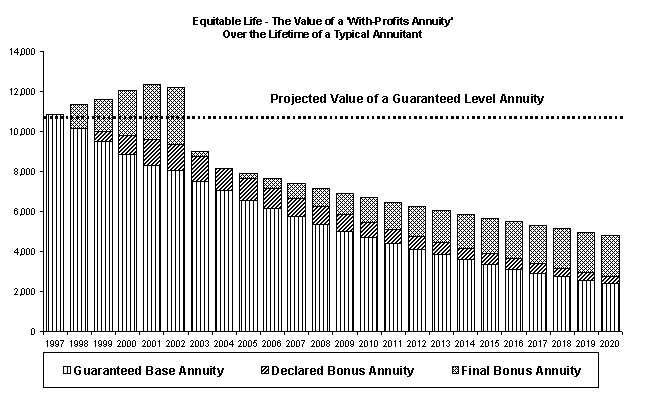|
|||||
LITIGANTS' NEWSLETTER 18 Aug 2004 |
|||||
|
Litigants
Newsletter
18 August 2004 I
imagine that many of you will be wondering what has happened since Clarke
Willmott issued the Claim Form on your behalf by on July 15th 2004. Well,
these have not been idle times. Apart from trying to lead as normal lives as is
possible, the committee is probably working around 4 to 5 hours per day, every
day including weekends on this project. I am pointing this out, not for a vote
of thanks, but because if things seem to take longer than you expect or it all
goes quiet it is not that we are not active on your behalf. Having
said that we will try and keep you up to date with our actions as often as we
are able. As
of today we have some 733 members who have decided to join in the litigation
plus another 143 members who are partners and need to be identified separately.
I say as of today as we can accept new Claimants provided that the contract date
of their annuities commenced less than 6 years from the point at which they are
added to the Claim Form. At
present, the major effort of the Legal Action Committee and Clarke Willmott is
to agree the precise terms of:
These
documents have to be very carefully worded to protect the members and the
directors acting on behalf of the members. Fortunately Nicholas Oglethorpe and
Nicolas Bellord, both members of the committee are ex-solicitors and whilst they
have long ceased being in practice, they have retained their sharp eyes and
brains and are working closely with the legal team at Clarke Willmott to ensure
that we present the best possible documents to you and that our relationship
with Clarke Willmott is a tightly defined as is possible. We
expect these documents to be completed by the end of August at which time they
will be sent you by Clarke Willmott and which you will be required to sign. At
the same time, the Group Litigation department at Clarke Willmott will contact
each of you by phone to explain the terms of the Conditional Fee Agreement to
you personally so that you are absolutely clear what is being offered and what
you are being asked to sign. In
parallel, Clarke Willmott have selected a large number of sample cases that will
be reviewed in great detail both by themselves and Mr Palmer, the Leading
Counsel that we have retained on behalf of ELTA. This will involve a long
discussion with staff at Clarke Willmott and the responses plus their files will
be sent to Mr Palmer who will prepare the precise complaint against the Society.
Time is always a variable but we expect that to be ready by the end of
September/ early October. However,
it is clear that the generic claim ELTA will be making will cover some or all of
the following areas: 1
The
with-profits annuity was mis-described both by the salesmen and the product
literature. The
mis-description took the following forms. 1.1
The with-profits fund was
promoted as being a sort of unit trust invested in a wide range of investments.
Although the fund was invested, (largely in equities at the time) the dominant
feature was that the with-profits fund provided the Society’s working capital,
and with-profits policyholders were exposed to the success or failure of a
single business enterprise, that is to say the Equitable Life Assurance Society.
In effect they bet on one share and, that share, unlike a share in a limited
liability company, carried a degree of liability beyond the subscription to
capital involved. 1.2
The
with-profits annuity was offered as a low risk product. The with-profits fund
itself was said to be of the same risk grade as the Society’s gilt and fixed
interest fund. That was not true and never was true. The Society’s with -
profits fund carried a vastly greater risk than any gilt and fixed interest
fund. 1.3
The
success of any with-profits annuity depends upon the life assurance company
writing it having sufficient estate to provide the smoothing process, which is
at the root of the with-profits concept. In fact the Society did not have the
necessary estate to offer that smoothing process. This necessary ingredient for
the with-profits annuity to be successful was therefore absent. 1.4
The
with-profits annuity carries an increasing risk to the annuitant and a
decreasing risk to the Society the longer it remains in payment. This escalating
risk was not explained in the product literature; the risk of the with-profits
annuity, such as it was explained by the Society, was explained as a level risk
and not as an escalating risk.
Thus the possibility of a sudden cut in income, such as those, which have
occurred since late 2002, was not explained. In describing the with-profits
annuity as low risk, the Society mis-described it. 1.5
The
Equitable with profits annuity was described as capable of providing reliable
income in retirement for life. Indeed, it was an implied term of the contract
that it should. In fact it was incapable of doing do. 2
The
annuitants’ necessary understanding of the product they were buying was
absent. This is because the training of the salesforce on the complexity and
risk of the product was defective and therefore these were not communicated to
the annuitants. In particular 2.1
many
annuitants did not realise that their income was made up of two income streams,
one guaranteed (but declining), the other discretionary. 2.2
those
annuitants who did realise the annuity contained these two elements did not
realise that the bonus element, once granted, could be removed. 2.3
no
annuitant thought that a cut in income of 20% or more was possible under the
contract. As
you can see, these are very well grounded complaints and represent a broad basis
for a claim that will embrace all of us. Of course that means that we have to
give up some specific personal claims of mis-selling but that should not affect
the amount of compensation that might be awarded to us by the court and enables
us to participate in this litigation, which would otherwise be unaffordable for
most of us. I am often asked how much can I expect in compensation should our claim prevail. This is a very difficult area but one way to assess the potential loss a WPA might have made is to look at what is called the “Alternative Transaction”. For many WPA’s, we would have taken a conventional guaranteed level annuity for life. If we look at the chart below which is based on a typical WPA’s figures, we can immediately see the effect of the future reductions in our annuities that have already been forecast by Mr Thompson for this annuitant assuming he dies aged 80 in 2020. Expressed in numbers, his loss will be approximately Ł70,000. Some of this will be offset by the GAR Compromise and of course he will argue he comes from a long lived family and is in excellent health and thus will live longer than average and is entitled to a bigger sum in compensation. For every WPA the calculation will be different, based on when the annuity started, higher Annuity Rates, the age of retirement, state of health and other factors, but you can see the basic picture. You might also note that whilst in 2004, this WPA’s Final Bonus Annuity was reduced to zero by the Society’s actions, something we believe is not permitted under the terms of our contract with the Society, it then begins to increase again so that by 2015 it again represents a substantial proportion of the annuity. Unless, we take action to prevent it, there is no reason why the Society could not try and repeat the same exercise again and decide unilaterally to remove another 30 to 40% of our income.
We must also make you aware that the Board of Equitable and their solicitors, Lovells are and will be trying to intimidate you. They have asked for all the names of claimants, Clarke Willmott have replied that they will only agree to forward these names on the firm understanding that no direct approach will be made to any individual claimant. Whilst I am reasonably certain that they will accept this condition, we can still expect various ''unsettling' announcements from Mr Thomson and Mr Treves through the media all of which are designed to weaken our resolve. In fact for those of you who have participated in litigation before, you will be familiar with the actions of lawyers and barristers whose perfectly reasonable objective is to do their best for their client, prevent the case coming to court if at all possible or at least minimise the cost exposure by so frightening the claimants that they settle for less than they might have obtained with some hard nosed bargaining. I see interesting and exciting times ahead for us all. As
ever, if you have any questions or concerns, the committee is only too willing
to help you in any way that it can, so please e-mail or phone me, details on the
ELTA web site, or contact Tim Balkwill or Nicholas Oglethorpe, details also on
the ELTA web site. Peter
Scawen
|
|
||||

